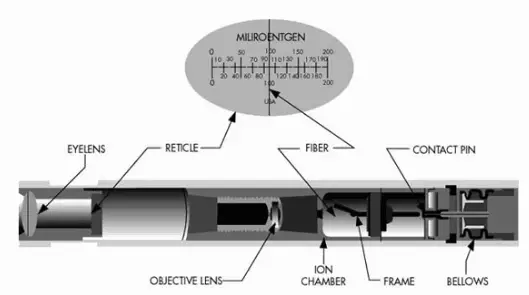Self-reading dosimeters are field-readable devices worn on the body to measure an accumulated dose. These are unpowered devices that do not contain a battery. Devices in this group include:
- Quartz fiber dosimeter. A quartz fiber dosimeter, called a self-indicting pocket dosimeter (SIPD), is a pen-like device that measures the cumulative dose of ionizing radiation received by the device, usually over one work period.
- Self-developing photochemical cards. The self-developing photochemical card is a credit card-sized, instant color-developing emergency dosimeter. It is designed to monitor exposure in a radiological incident for medical treatment triage and minimize worry and panic.
They display the dose to the wearer using an analog scale or color indicator; they do not have alarm capabilities. Self-reading dosimeters are less precise devices applicable to situations where real-time information may be needed to make tactical decisions but where electronic dosimeters are not practical.
Quartz Fiber Dosimeter – Self-Indicating Pocket Dosimeters

A quartz fiber dosimeter, called a self-indicting pocket dosimeter (SIPD), is a pen-like device that measures the cumulative dose of ionizing radiation received by the device, usually over one work period. As the name implies, they are commonly worn in the pocket. The self-indicating pocket dosimeter consists of an ionization chamber with a volume of approximately two milliliters sensitive to the desired radiation, a quartz fiber electrometer to measure the charge, and a microscope to read the fiber image off a scale. Inside the ionization chamber is a central wire anode, and attached to this wire anode is a metal-coated quartz fiber.
Quartz fiber dosimeters are charged to a high voltage and are usually used for one work period only. Electrostatic repulsion deflects the quartz fiber, and the greater the charge, the greater the deflection of the quartz fiber. As the dosimeter is exposed to radiation, ionization occurs in the surrounding chamber, decreasing the charge on the electrode in proportion to the exposure. The deflection of the moveable quartz fiber electrode is projected by a light source through an objective lens to a calibrated scale and read through a microscope eyepiece. Self-indicating pocket dosimeters are now being superseded by more modern types, such as electronic personal dosimeters.